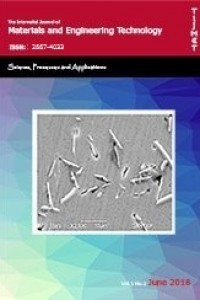EFFECT OF PROPELLERS NUMBERS AND HORIZONTAL DISTANCE IN DESIGN OF VTOL
EFFECT OF PROPELLERS NUMBERS AND HORIZONTAL DISTANCE IN DESIGN OF VTOL
VTOL Propeller, Aerodynamic Parameters, Flow Analysis,
___
- The Wikipedia website. [Online]. Available: https://en.wikipedia.org/wiki/Propeller (accessed on 2 November 2021).
- S.Baskaran.; L.Dhineshraj.; J.Dinesh.; B.Dineshkumar.; T.Dineshkumar., Design and Flow Analysis of Marine Propeller using Computational Fluid Dynamics, International Journal of Research and Scientific Innovation,2019,56-58.
- Subhas, S., Saji, V. F., Ramakrishna, S., & Das, H. N. (2012). CFD analysis of a propeller flow and cavitation. International Journal of Computer Applications, 55(16).
- Patil, V., Purushothama, H., Manjunatha, A., & Mishra, V. K. (2016). Performance Evaluation of Marine Propeller using Numerical Simulation. Indian Journal of Science and Technology, 9(45).
- Kutty, H. A., & Rajendran, P. (2017). 3D CFD simulation and experimental validation of small APC slow flyer propeller blade. Aerospace, 4(1), 10.
- Seo, J. H., Seol, D. M., Lee, J. H., & Rhee, S. H. (2010). Flexible CFD meshing strategy for prediction of ship resistance and propulsion performance. International Journal of Naval Architecture and Ocean Engineering, 2(3), 139-145.
- İbrahim, G. Ö. V. Rotor Spacing and Blade Number Effect on the Thrust, Torque and Power of a Coaxial Rotor. El-Cezeri Journal of Science and Engineering, 7(2), 487-502.
- Doğru, M. H., Güzelbey, İ. H., & Göv, İ. (2016). Ducted Fan Effect on the Elevation of a Concept Helicopter When the Ducted Faintail Is Located in a Ground Effect Region. Journal of Aerospace Engineering, 29(1), 04015030.
- Hong, F. W., & Dong, S. T. (2010). Numerical analysis for circulation distribution of propeller blade. Journal of Hydrodynamics, Ser. B, 22(4), 488-493.
- Zhang, C., Xie, S., & Qin, T. (2016, April). Aerodynamic analysis of small propeller in wind field using CFD. In Proceedings of the 2015 4th International Conference on Sustainable Energy and Environmental Engineering.
- Oktay, T., & Eraslan, Y. (2020). Computational fluid dynamics (Cfd) investigation of a quadrotor UAV propeller. In International Conference on Energy, Environment and Storage of Energy (ICEESEN 2020) (pp. 1-5).
- Simutech group website. [Online]. Available: https://simutechgroup.com/why-is-meshing-important-for-fea-fluid-simulations/ (accessed on 2 November 2021).
- Brandt, J., & Selig, M. (2011, January). Propeller performance data at low reynolds numbers. In 49th AIAA Aerospace Sciences Meeting including the New Horizons Forum and Aerospace Exposition (p. 1255).
- Deters, R. W., Ananda Krishnan, G. K., & Selig, M. S. (2014). Reynolds number effects on the performance of small-scale propellers. In 32nd AIAA applied aerodynamics conference (p. 2151).
- Yayın Aralığı: Yılda 2 Sayı
- Başlangıç: 2018
- Yayıncı: Necip Fazıl YILMAZ
EFFECT OF PROPELLERS NUMBERS AND HORIZONTAL DISTANCE IN DESIGN OF VTOL
Mustafa VARKİ, Eyüp YETER, Mehmet Hanifi DOĞRU
Doğan ACAR, Salim Levent AKTUĞ, Kemal KORKMAZ, Salih DURDU, Ömer Necati CORA
ANALYSIS OF WIND TURBINE BLADE PITCH ANGLE CONTROL WITH FUZZY LOGIC
Oğuzcan GÜZELİPEK, Tuğrul SOYUSİNMEZ, Furkan ÇETİN
Nasır MOHAMMED TAHIR, Adamu Umar ALHAJİ, Ibrahim ABDULLAHİ
EFFECT OF DIFFERENT AMOUNTS OF CARBON FIBER ADDITIVE ABS ON THERMAL DISTORTION AND COOLING TIME
Ömer EYERCİOĞLU, Engin TEK, Mehmet ALADAĞ, Gülağa TAŞ
ANALYSIS OF MECHANICAL BEHAVIOR OF TERMOPLASTIC COMPOSITES
Ali Taner KUZU, Elifnur KÖSEMEN, Aysu Hande YÜCEL, Mustafa BAKKAL
INVESTIGATION OF THE HUB DIAMETER EFFECT ON PROPELLER THRUST
Enes COŞKUN, Mehmet Hanifi DOĞRU
Mahmut Furkan KALKAN, Murat ARTAN, Hasan Mithat DELİBAŞ, Abdulcabbar YAVUZ, Necip Fazıl YILMAZ
